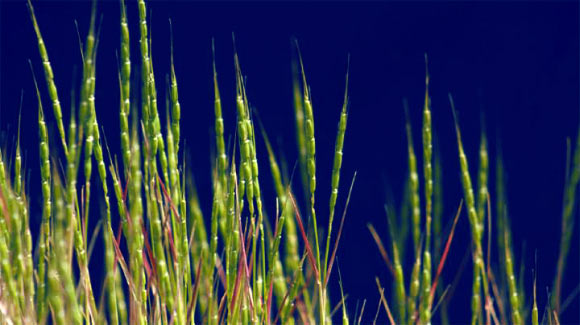An international team of researchers led by the University of California, Davis, has sequenced the genome of the Tausch’s goatgrass (Aegilops tauschii), one of the three progenitors of bread wheat.

The Tausch’s goatgrass (Aegilops tauschii), also known as the rough-spike hard grass, is a self-pollinating goatgrass species in the Triticeae tribe of the grass family. It is native to temperate Asia and the tropical Asian Indian Subcontinent, the Caucasus region in Eurasia, and Ukraine in Eastern Europe. Image credit: Patrick McGuire / University of California.
About 8,000 years ago in the Fertile Crescent, a spontaneous hybridization of the wild diploid Tausch’s goatgrass with the cultivated tetraploid wheat Triticum turgidum resulted in the hexaploid wheat Triticum aestivum.
Wheat has since become a primary staple crop worldwide as a result of its enhanced adaptability to a wide range of climates and improved grain quality for the production of baker’s flour.
Despite the exceptional importance of wheat, a high-quality draft reference sequence of its genome is not available due primarily to its hybrid origin and the enormous size of the genome.
To assist the international bread wheat genome sequencing effort, University of California Professor Jan Dvorak and co-authors generated a reference-quality genome sequence for the Tausch’s goatgrass, which is highly adaptable and tolerant of diseases.
The findings will allow scientists to discover new genes that can improve wheat baking quality, resistance to diseases, and tolerance to extreme environmental conditions like frost, drought and salinity.
The effort has already had one practical result: the discovery of two new genes for resistance to a race of wheat stem rust to which there is virtually no resistance in wheat.
The genes were transferred from the Tausch’s goatgrass into wheat and are now available to wheat breeders.
“Wheat and its wild ancestors have genomes much larger than humans, which makes sequencing difficult,” Professor Dvorak said.
“When we started this project nearly two decades ago, there was no technology to sequence genomes of that size and complexity.”
“This group of plants are unique because their genomes are just absolutely full of repeated sequences.”
“We found more than 84% of the Tausch’s goatgrass genome consists of closely related repeated sequences.”
The team’s results are published in the journal Nature.
_____
Ming-Cheng Luo et al. Genome sequence of the progenitor of the wheat D genome Aegilops tauschii. Nature, published online November 15, 2017; doi: 10.1038/nature24486







